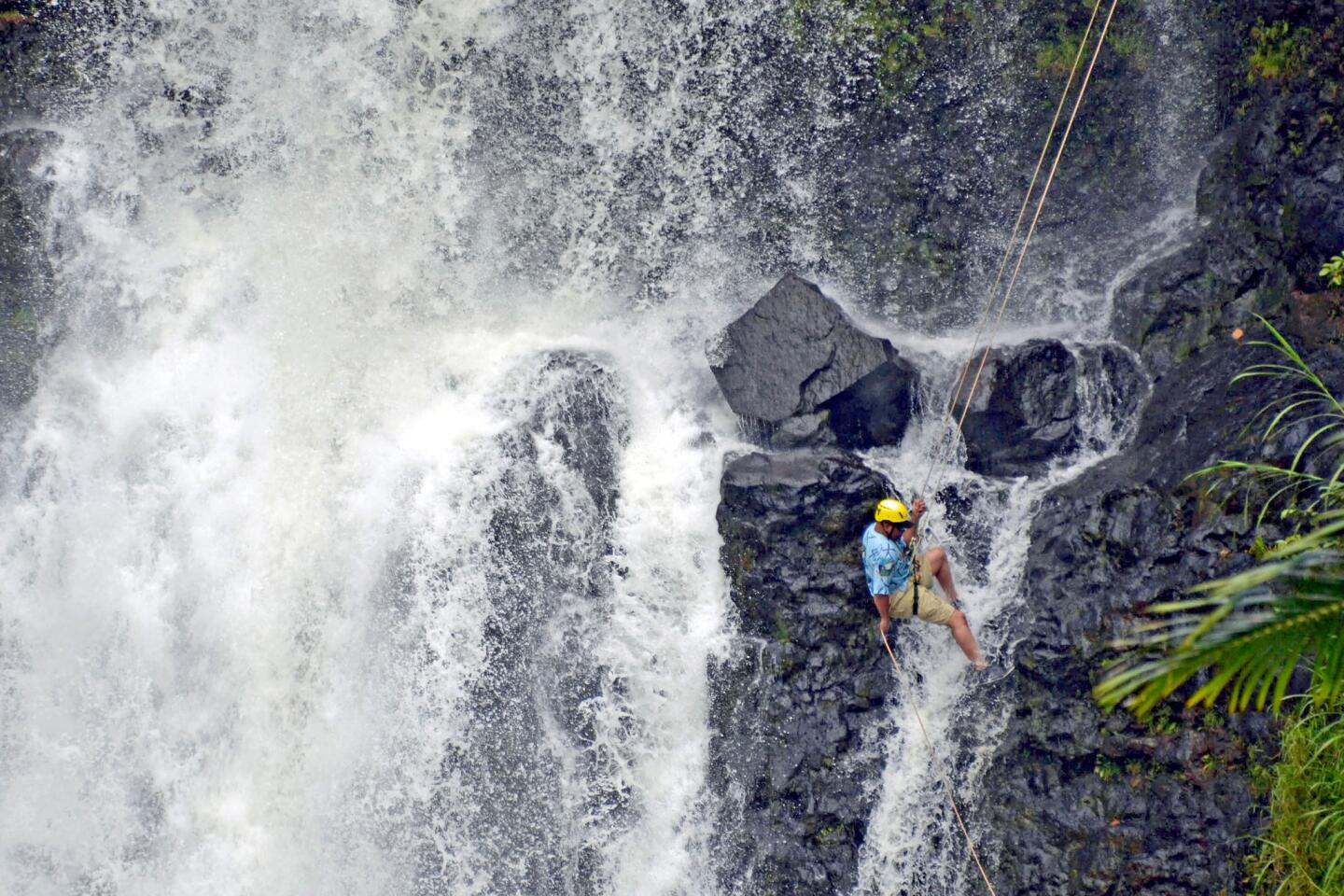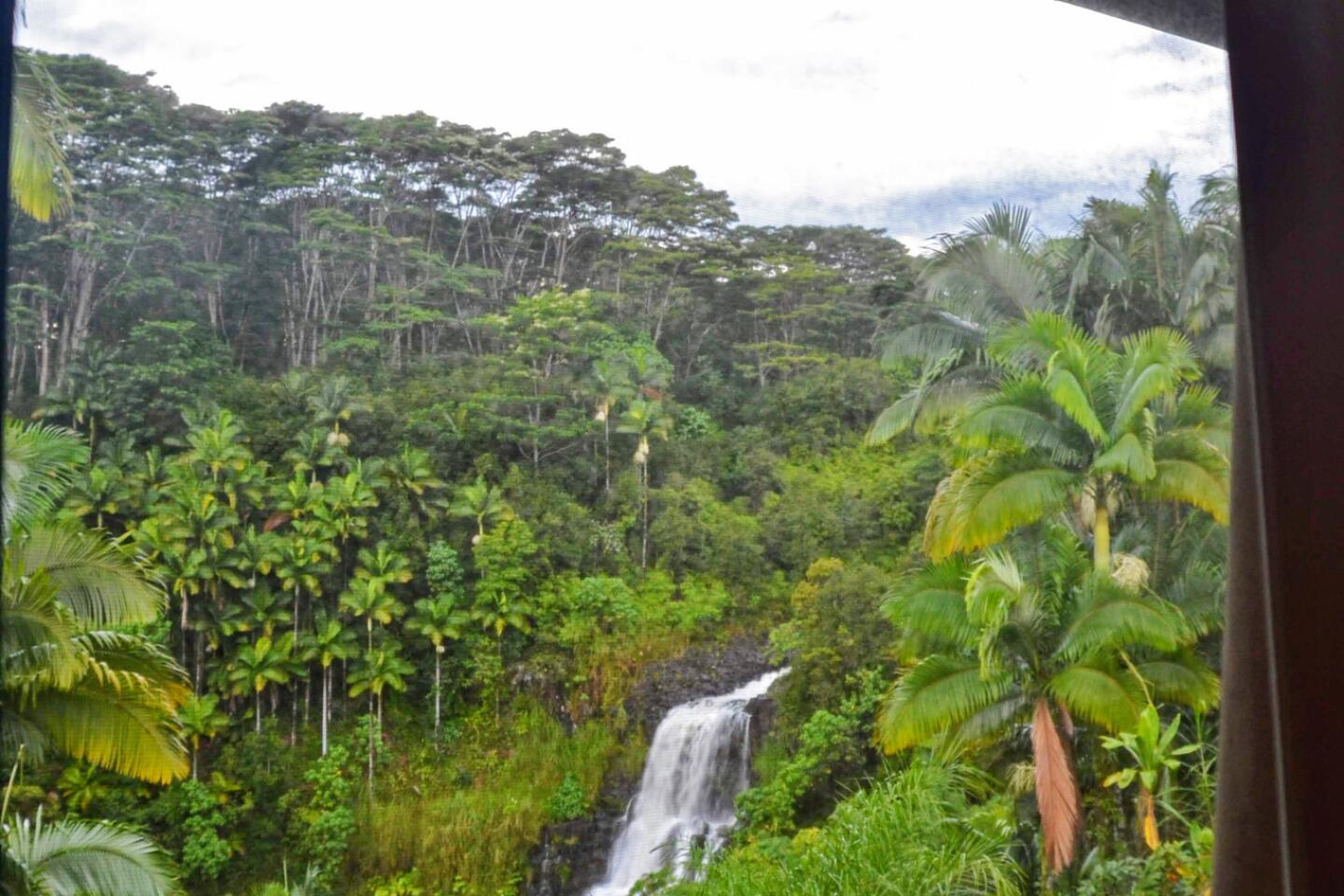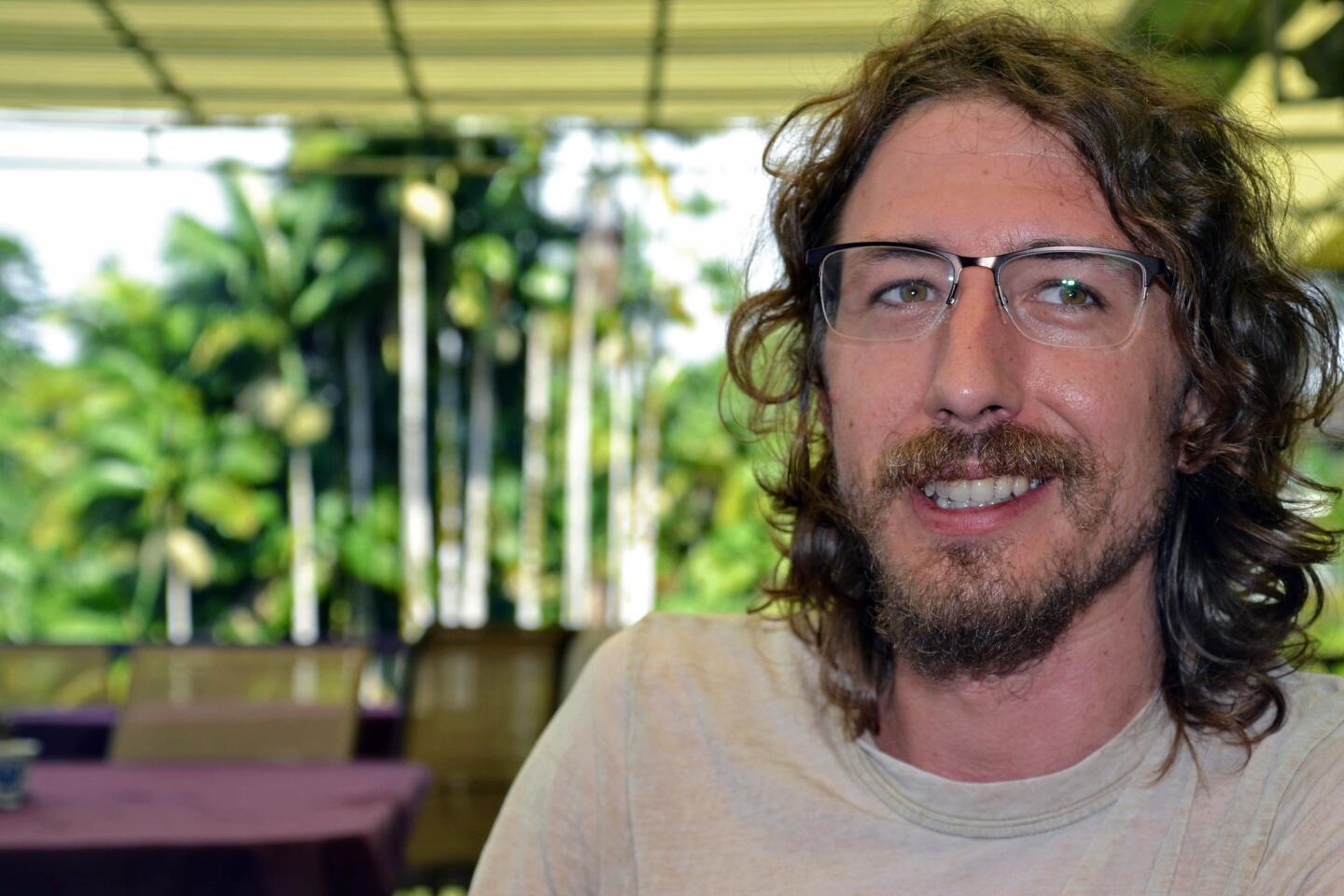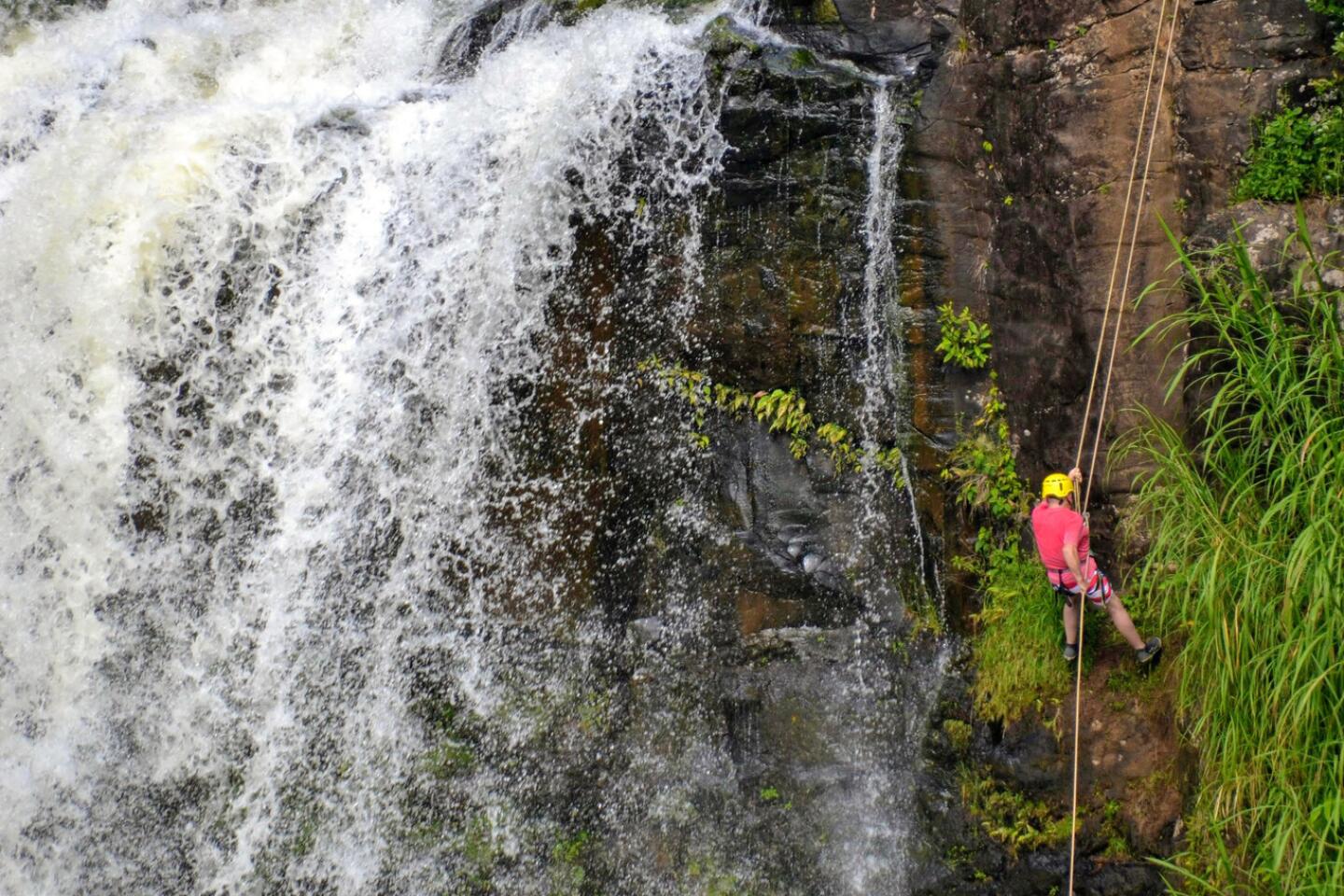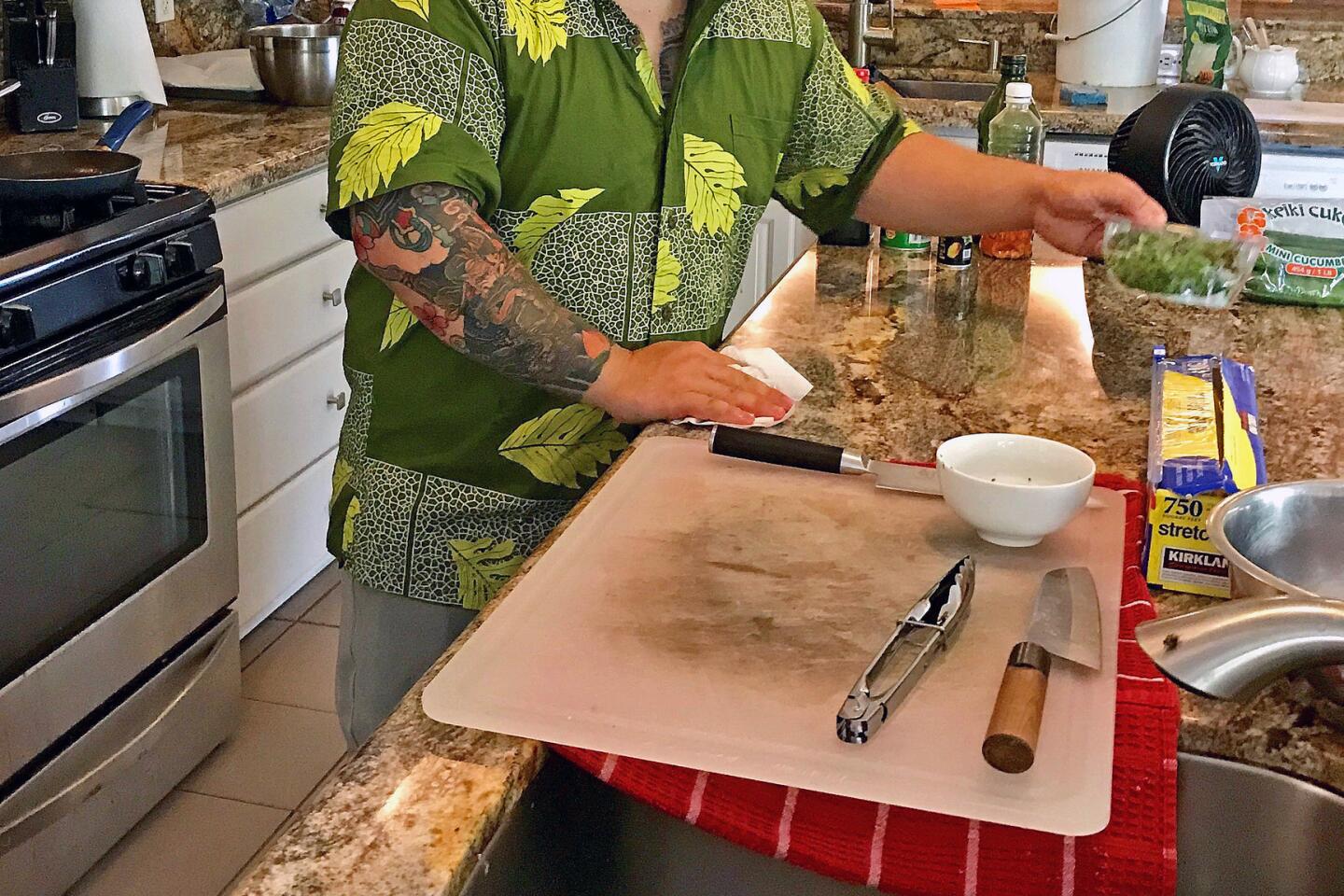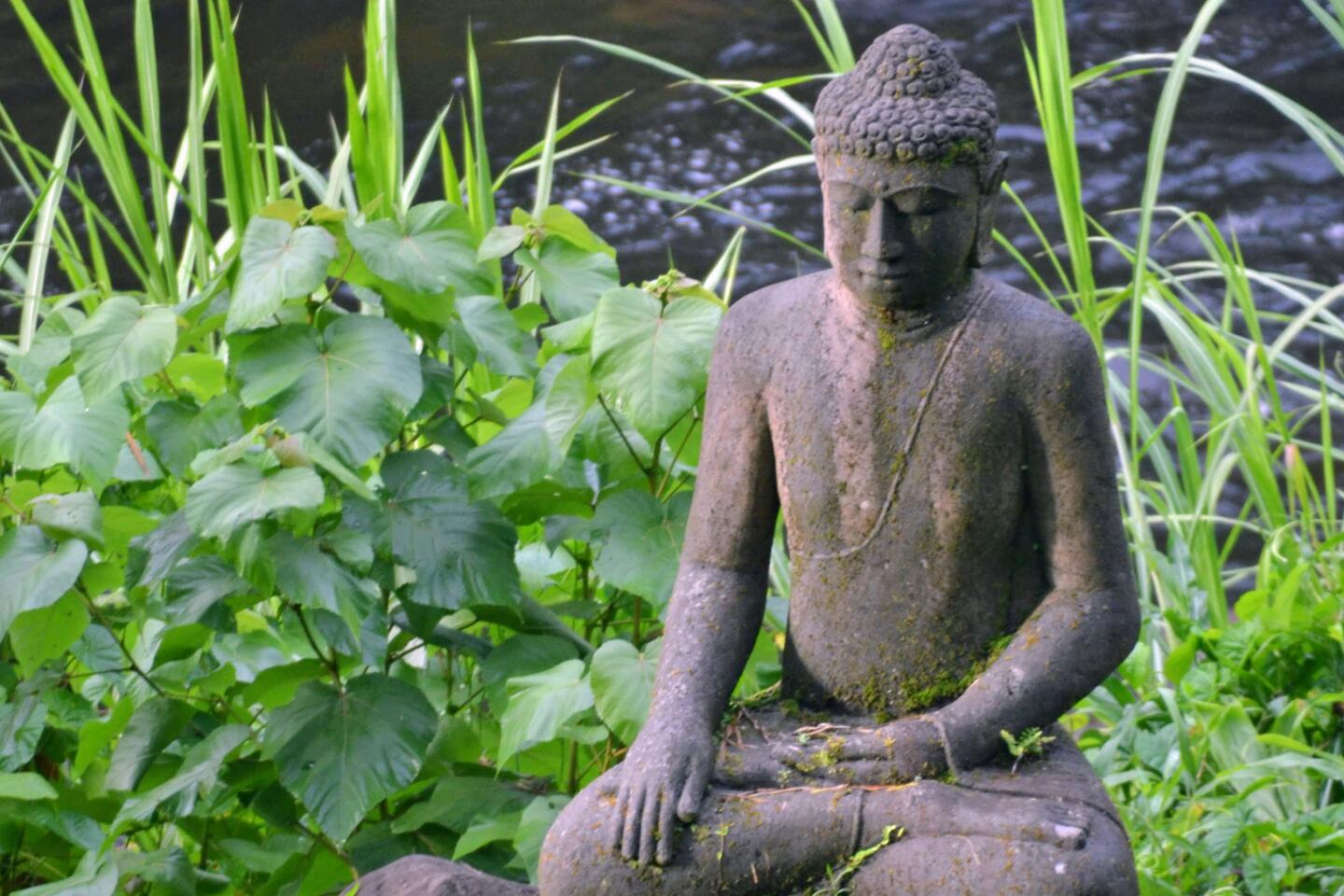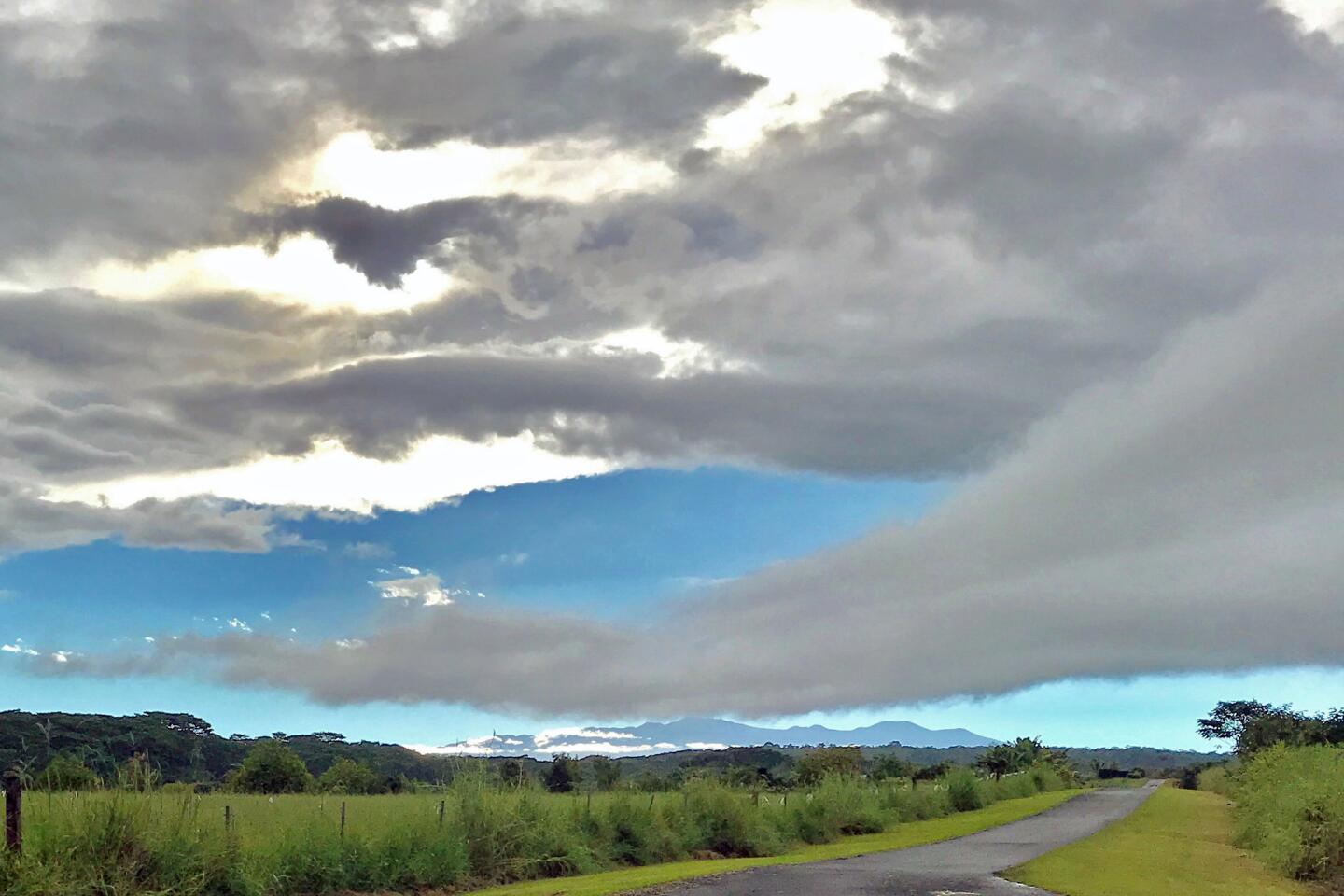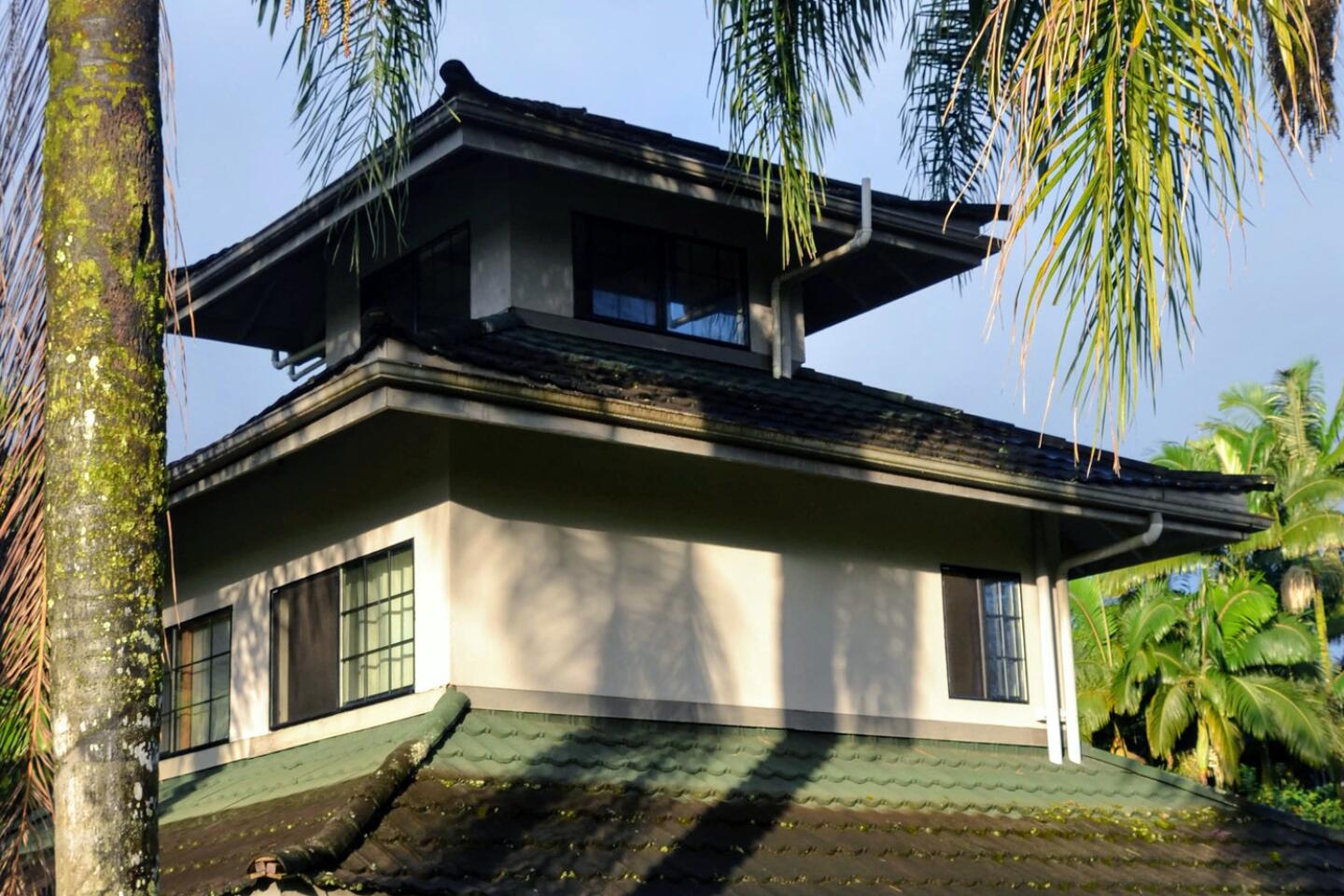Must Reads: On Hawaii Island, nature nurtures guests at an unusual inn
- Share via
Reporting from Hilo, HILO, Hawaii — If you arrive here on a moonless night, you can hear the water before you can see it rushing to seek its lowest point, as water always does. At first, it sounds like a hose that’s been left on, but as you try to track down the source, it begins to sound like a horrendous L.A. water main break.
Suddenly it appears seemingly out of nowhere: Kulaniapia Falls, not a public works disaster but an aquatic masterpiece that tumbles over itself on its 120-foot drop to the pool below, spilling 50 bathtubs worth of water in a minute if it’s not raining, about 10 times that much if it is, which it often is on the Hilo side of Hawaii Island.
For years, vegetation hid these falls. Once that greenery was cut away, the cascade became the centerpiece of and the soundtrack for the Inn at Kulaniapia Falls.
This is a different kind of resort, not the marble-bathed, Frette-linened, chilled-air kind of lodging you frequently find in the islands. Want pampering? No problem, but here it is nurture by nature. It’s the gardens filled with bamboo and orchids, the early morning sun glinting off Hilo Bay below, the feeling of being free from artifice as you stroll down a country lane lined with macadamia nut trees.
And always there is the water, a kind of liquid worry bead. For one occasional group of guests, that is part of the allure of this place, which is more than just a resort. For some of them, it is a last resort.
Sight unseen
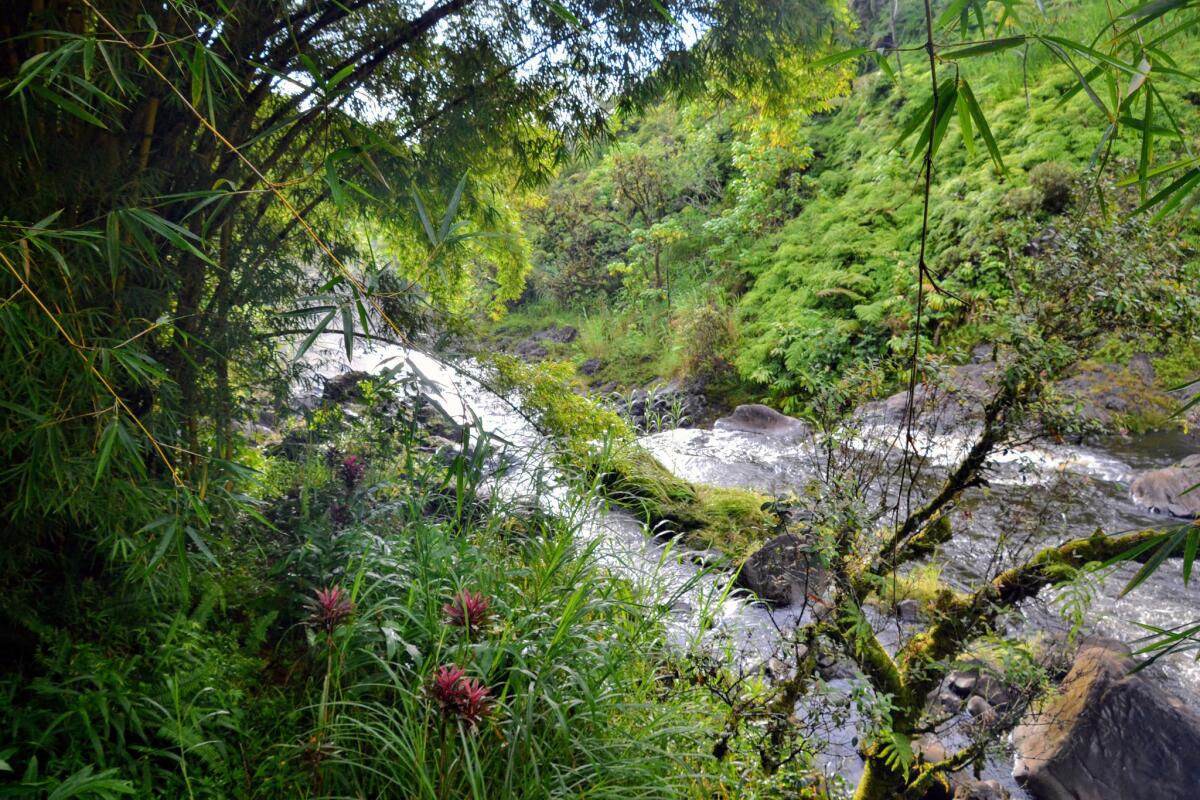
In the early 1990s, Lenny Sutton bought sight unseen the 22 acres that are now home to the inn. “It had good mana,” he said, using a term that often refers to an energy or power that can result in good.
How the resort came to be what it is today is a tale of a lot of hard work, a little bit of luck and a whole lot of, well, you decide what the word is once you know the story.
Sutton, his wife, Jane, and their children moved here because the place had, as they like to say in real estate, potential, but it took vision to see what that was.
Want to become a celeb on Maui? Rent a ’75 VW camper van and watch heads turn »
The falls were so overgrown that only the top 12 feet were visible. There were no buildings, only the land and the water — the big falls, three smaller falls and the stream into which they flow.
The inn began its hospitality life as a four-room bed-and-breakfast.
“We raised our kids there,” Sutton said.
If hospitality is a calling — and he had been for years a Caribbean charter boat captain — it’s also a 24/7 commitment, no weekends, no holidays. Christmas morning was never the bound-down-the-stairs-before-dawn Hallmark card for this family. “I was always cooking breakfast for the guests,” he said.
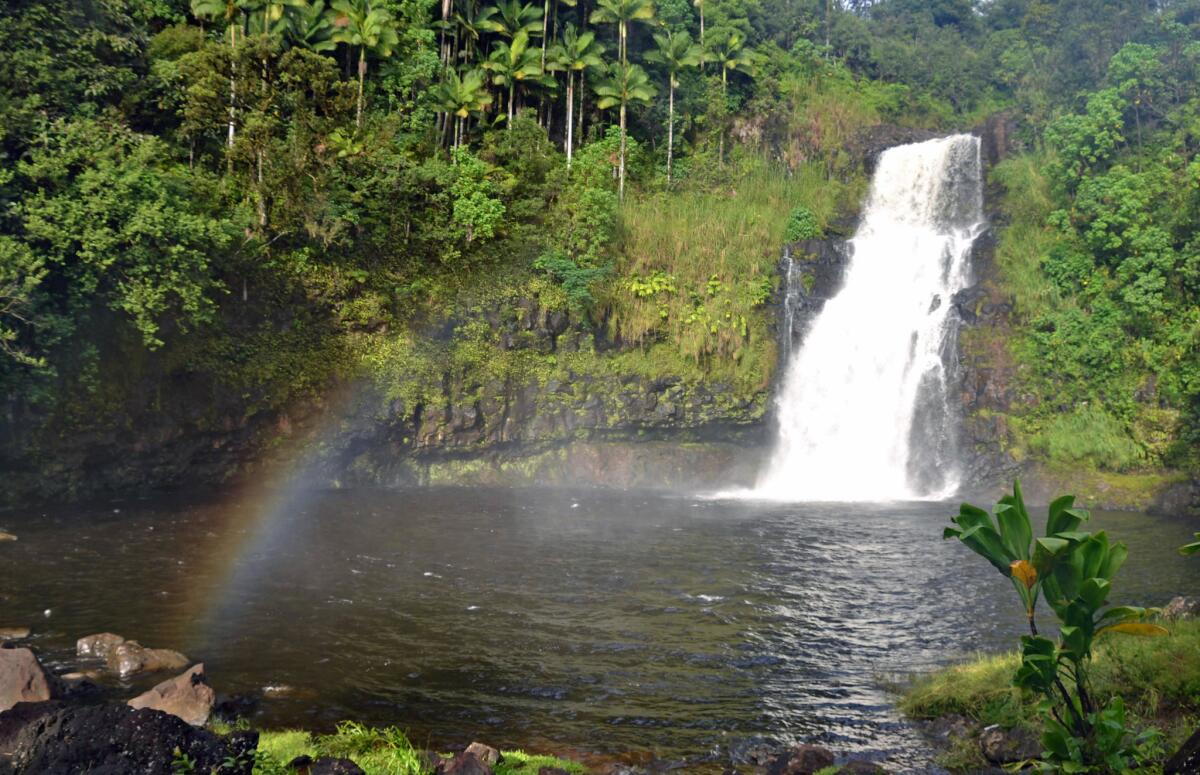
Today, the inn comprises the Residence (four rooms) and Harmony House (five rooms), Jade Cottage (sleeps two) and the Pagoda House (sleeps four and has a kitchen). There are glamping tents up the road at the 20-acre farm that can be booked through Airbnb (from $89).
Breakfast is part of the package at the inn (fruits, breads, cold meats, cook-your-own waffles, juices, coffee) and can be eaten on the balcony of the Residence, where the falls could easily rock you back to sleep, if there weren’t so many other things to do.
Those things are fairly recent additions. In 2015, Sutton was retirement age and perhaps ready for a not-seven-day-a-week job, so he put the place on the market.
Enter Christophe Bisciglia, whose mile-a-minute mind had plowed mostly fertile land in the tech industry. Now he was ready for what he called a “legacy asset” that enabled him to be part of and contribute to a local and larger community. By chance, he stumbled on the inn. It wasn’t quite what he thought he wanted, but when he saw Kulaniapia (said to mean “heavenly power”), he knew this was it.
He didn’t want to buy the inn outright. Instead, he wanted to partner with Sutton as he learned a new industry. In the end, as it often does, life gave Sutton what he needed (a partner to ease his burdens), not what he thought he wanted.
New adventures
Bisciglia wanted to create new revenue streams by introducing adventures — hikes in a nearby lava tube, stargazing, and rappelling and ziplining the falls — for the guests.
To do so, he needed someone who could train a staff to guide the guests.
Enter Dave Black, a Maui resident but a Utah native. He had decades of outdoor experience as part of credentials that also included military service and serving as a correctional officer.
Black was interested, but his motivation wasn’t money. He wanted to find a way to honor his son Darby, a military veteran who served in Afghanistan and Iraq and suffered post-traumatic stress disorder so severe that in 2015 he killed himself.
Darby Black is part of a deadly pattern. In 2010, about 22 vets a day killed themselves, according to an estimate in a 2012 Department of Veterans Affairs study. The rate is even higher among older vets who did not serve in Iraq or Afghanistan. Some scientists and medical personnel dispute the numbers, but no one thus far has disputed the problem.
That is how Brian, Lee, Christian and Jim, under the leadership of Dave Black, came to be at the Inn at Kulaniapia in August, the second group of a still developing program for vets scarred by war. Airfare, lodging (they stayed in the glamping tents), meals and activities are provided.
This is no free lunch. Slaying the dragons of memory takes as much grit as the military service that created them — and maybe more.
Lava tube hike
The vets would do the same things as the other guests but in their own group. They let me join them on a lava tube hike at Kazumura Cave in Pahoa, about 25 miles from the inn. It’s on private property, but Sutton is friends with the owner, who has granted permission for the inn’s tours.
Ethan Hodek, then an inn staffer, led the group through a small opening into the cave, which was formed at least 500 years ago. Some of the mile or so hike is along smooth lava (pahoehoe) and some sharp (aa).
On Oahu, 20 places for great meals for less than $20 »
Sometimes we needed to crouch and sometimes the ceiling was 30 feet tall. The path was wide and then it was narrow. One embankment required a skitter up a rope—skitter for the guys, grappling and groaning for the generally deskbound reporter.
We stopped at one point, turned off our flashlights and helmet lamps, and held our hands in front of our faces. At least, I think they were in front of our faces. It was the blackest black I’ve ever experienced. Was this the dark night of the soul? If so, where was the illumination that is supposed to follow?
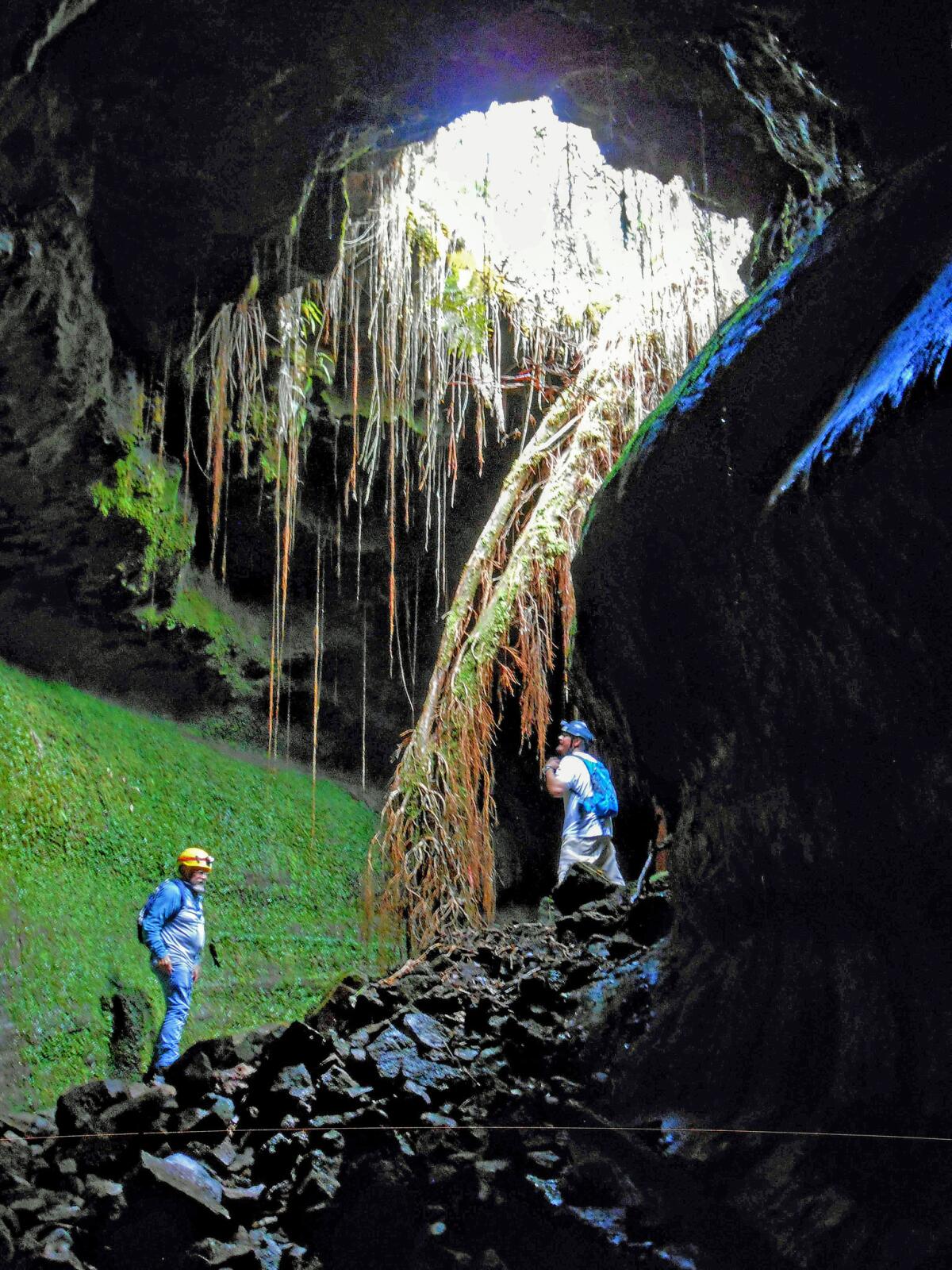
Not too much farther, it turned out. There was light—not at the end of the tunnel, which goes on for more than 40 miles—but at a “skylight,” an opening through which roots from ohia trees dripped and, based on bones found, animals apparently fell.
Hodek and Black had urged us to stay hydrated. I was more focused on staying upright. On the return to the entrance, I took Brian’s arm, afraid I would fall, petrified I would embarrass myself, concerned I would lose credibility.
With help, I made it up the final ladder and out. I spent the rest of the day swaddled in ice packs.
The next morning, I ran into Jim, who had served as a paratrooper in Vietnam and has two artificial hips, two bad knees and two fused ankles. He noticed I was limping and asked why I hadn’t turned back. I said I couldn’t lose face, not in front of this group.
He told me, not unkindly, that I should never let anyone’s opinion determine my course of action. Of course not, I said, but it was also my job.
He smiled slightly and nodded.
Journeys back
I took a safer position on the breakfast terrace as the group prepared to rappel the falls. (Few guests have failed to complete the rappel, and one of those was an octagenarian, Bisciglia told me.) These guys weren’t going to chicken out. One by one, under the watchful eyes of guides and staff, they made their way down next to those fast-and-furious falls, as though they did so every day.
Part 2 was to have been ziplining from the falls to the pond, but the forecast called for thunderstorms. Mission aborted. The rain started coming down in sheets. “At home,” one British guest remarked, “we call this liquid sunshine.”
The liquid sunshine turned into a flash flood, so I hunkered down until it passed, then joined the guys that evening in the converted barn on the farm to hear the stories of what had brought them here.
For two hours, they told of broken relationships, drinking, drugs, always depression, often despair and usually enormous confusion. Sometimes they had to walk away from the conversation. Sometimes they gutted it out and told what ripped their hearts out and still messed with their minds.
Most of them had lost friends. Some died in combat; others by their own hand.
The next day on the farm, they planted trees to honor their fallen comrades. Holes were dug, and words were summoned to remember their friends.
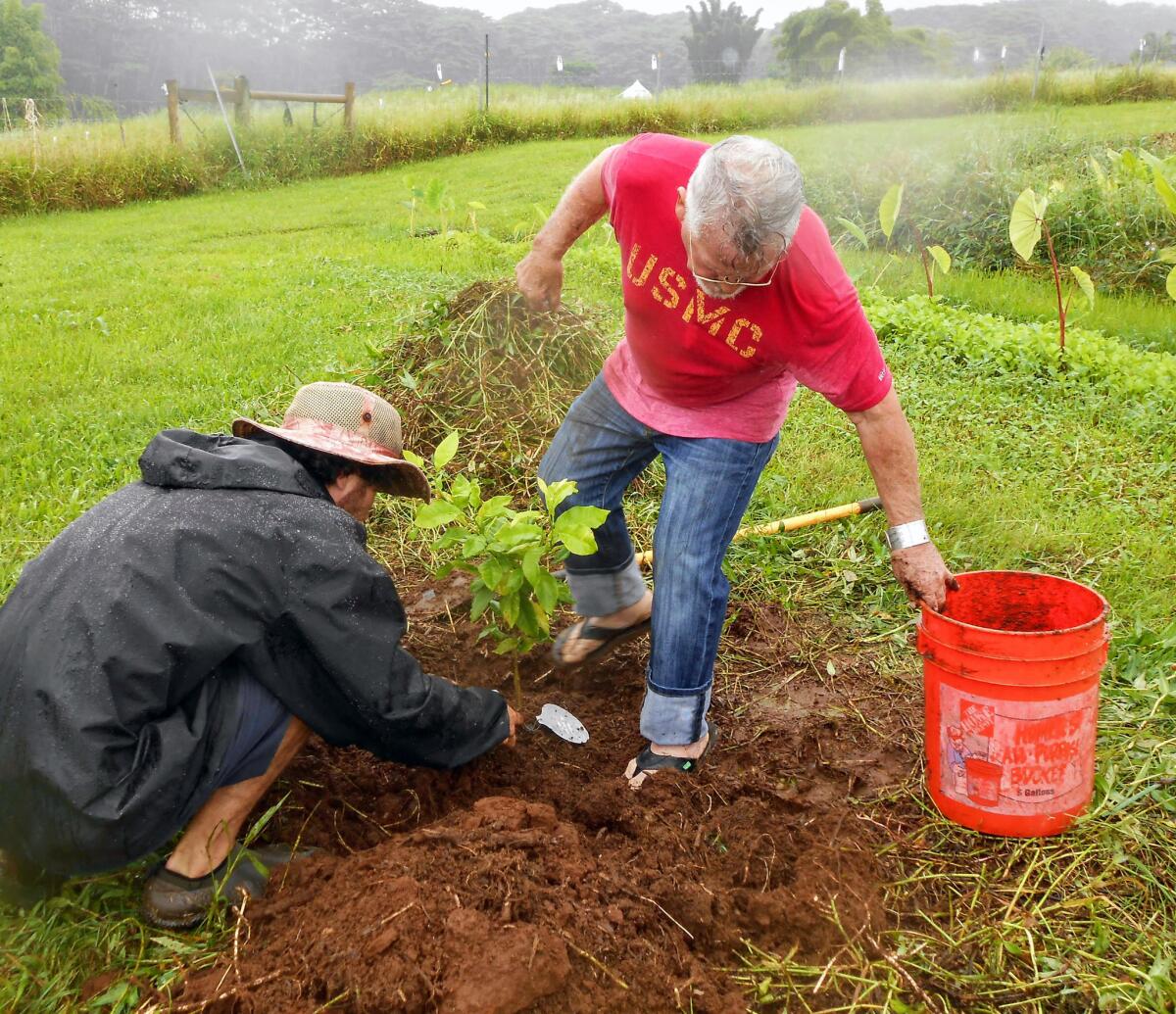
Never have I heard “S.O.B” spoken as tenderly.
Earth patted back into place, rain now gently falling, the men turned and walked away to begin a new chapter in their journeys back.
Mana indeed.
If you go
THE BEST WAY TO HILO, HAWAII
From LAX, United offers nonstop service and Hawaiian offers connecting service (change of planes) to Hilo. (Other airlines connect to Hilo on Hawaiian.) Restricted round-trip fares begin at $519 , including all taxes and fees.
WHERE TO STAY
Inn at Kulaniapia Falls, 100 Kulaniapia Drive, Hilo; (808) 935-6789. Doubles from $159, including breakfast.
WHERE TO EAT
Lucy’s Taqueria, 194 Kilauea Drive, Hilo; (808) 315-8246. Why would you eat Mexican food in Hawaii? Because you can be seated, it’s delicious and it’s inexpensive, which makes it popular. The taqueria taco plate (three tacos, rice, beans) was a bargain at $9.45. Main dishes from about $7.
New Chiang Mai Thai Cuisine, 110 Kalakaua St., Hilo; (808) 969-3777. Noodles, stir-fry and curry from $13.95; servings are large, so dinner was also lunch and dinner the next day (and even the spring rolls held up well).
Private chef, Inn at Kulaniapia Falls. The inn does not have a restaurant, but it does allow you to hire a private chef, who sets the menu depending on what’s in season and fresh. Chef Daysen Masuda prepared a meal for us that included a fresh ahi salad that reinvigorated my love for it. From $69 per person, $39 for children 12 and younger, plus a 15% gratuity. Dinners generally are for groups of four or more; six to eight is common.
Activities
Rappelling, lava tube exploration, stargazing and, by year’s end, horseback riding cost $199 a guest. Package rate available; check with the inn
TO LEARN MORE
To apply for the vets program: darby.waterfall.net
More to Read
Sign up for The Wild
We’ll help you find the best places to hike, bike and run, as well as the perfect silent spots for meditation and yoga.
You may occasionally receive promotional content from the Los Angeles Times.
